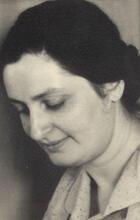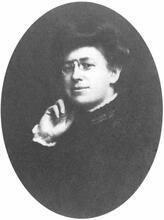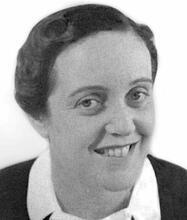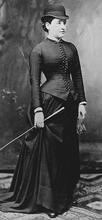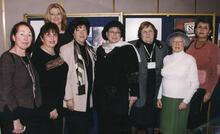Holocaust Survivors: Rescue and Resettlement in the United States
Immediately after the Holocaust, the American Jewish community shouldered the task of assisting in the resettlement of survivors who arrived in the United States. In 1946, United Service for New Americans (USNA) was created to oversee the national resettlement of survivors; New York Association for New Americans (NYANA) was founded in 1949 to assist the many newcomers who settled in New York. Individuals also sponsored surviving relatives. USNA and NYANA took the approach that survivors’ employment was the most direct path to becoming productive Americans. Their focus on work was informed by contemporary attitudes towards gender and age and often privileged agency agenda at the expense of survivors’ deeper needs. While Jewish communal organizations touted their successful efforts, the reality was less a triumphant narrative than a fraught and complicated process.
Getting to the United States
In the immediate aftermath of the Holocaust, survivors emerged from hiding, forests, the Soviet Union, concentration camp barracks, and other settings throughout formerly Nazi-occupied Europe. First and foremost was their search for any surviving family, but soon they began to consider their limited options for the future. Some ardently wished to go to Palestine, while some felt the pull of family ties in the United States. For others the destination was secondary to simply getting out of Europe.
In late 1945, President Truman issued a directive that allowed survivors’ initial immigration to America. The 1948 DP [Displaced Persons] Act pushed the door open a bit further. Eventually, some 140,000 survivors settled in the United States. These 140,000 newcomers were mainly between twenty and forty years old, a grim reminder that few young children or elderly people had survived. Records suggest, too, that slightly more men than women were among the survivors.
Truman’s directive was a turning point: it gave Jewish communal social welfare organizations in the United States the ability to provide “corporate affidavits” to survivors, the required sponsorship that ensured newcomers would not become public charges. This was in addition to the many individuals, usually relatives, who stepped forward to sponsor survivors. With these combined efforts, American Jewry assumed responsibility for survivors’ initial resettlement.
A new national agency was immediately created to oversee the refugee resettlement program: the United Service for New Americans (USNA), a merger of the National Refugee Service and the Service to Foreign Born Department of the National Council of Jewish Women (NCJW). Katharine Engel of the NCJW became the first chair of the USNA board. By the late 1940s, USNA grew to include hundreds of employees and numerous departments designed to help the immigrants become productive citizens of their new home.
Settling in New York and Across America
One of USNA’s goal was to resettle the refugees in communities all over the United States. To this end, USNA worked with local Jewish cooperating agencies, asking them to accept quotas of new immigrants in order to distribute the financial and practical burden to as many locations as possible. Some did so willingly, but other communities were less receptive. Still, almost every state sponsored some newcomers.
Although there was a push to move the recent arrivals away from New York City, many survivors preferred it to other cities. In addition to those who had relatives there, others recognized that it was the main center of American Jewish life. As a result, almost 50% stayed in New York City. This resulted in the creation of another agency in 1949: the New York Association for New Americans (NYANA), where Katherine Engel also played a key role. Many American Jewish women participated in other significant ways, including the majority of social workers who assisted the refugees and the volunteers who greeted them at the ports and docks. Indeed, since the turn of the century, NCJW had offered an array of services to assist immigrants, from location of relatives to Americanization programs, and USNA and NYANA continued this tradition in the postwar era.
Support and Challenges
Whether a survivor settled in Columbia, SC, or New York City, USNA and NYANA believed first and foremost that a refugee’s path to successful adjustment lay through work and self-support. Most newcomers, too, were eager to find employment. To this end, NYANA created an internal vocational service department, while local cooperating agencies worked with their hometown Jewish Vocational Services. In both cases, survivors received some minimal financial assistance until they were gainfully employed. Initially NYANA expected to assist survivors for five years. When NYANA’s caseload swelled in 1949, however, it decided to cap its financial help at one year. This time limit undermined agency as well as individual goals; for many, one year was simply not enough time to overcome obstacles such as a new language, job skills, anti-immigrant discrimination in the workplace, and physical and mental challenges resulting from the war. The records of agencies with no time limits, such as the Jewish Family and Children’s Services in Denver, reveal ongoing relationships with survivors that lasted for years.
Despite agency efforts, it soon became clear that the postwar newcomers were anything but typical immigrants. Simply finding jobs and learning English did not address the aftereffects of genocide. As case files from NYANA and USNA, as well as later oral testimonies, show, the survivors were clearly suffering. One measure of the extent of their suffering is the significant degree of illness recorded in case files during the first years in America. Some were physical ailments such as heart disease or the effects of tuberculosis, but many refugees suffered from psychological distress (what would now be termed Post Traumatic Stress Disorder, orPTSD). One woman’s case file described her insomnia and fear of entering subway trains. An older woman whose husband and daughter had been murdered detailed loneliness, ongoing sadness, and her inability to work despite her best efforts. Rather than connecting these symptoms to the traumas she had so recently endured, her psychiatrist diagnosed depression due to menopause as the root of her difficulties. Other examples highlight how mental health professionals diagnosed and treated survivors through a contemporary, and often gendered, lens.
Women, Work, and Motherhood
For married couples with children, the pressure to find work and get off agencies’ relief fell first on men’s shoulders. For women who did work, their income tended to be supplementary. In a 1953 study of survivors conducted in Detroit, the women who were or had at one time been employed saw their jobs primarily as a way to augment their husbands’ income, not as a path to a chosen career. Their occupations were traditionally female—nurses’ aides, seamstresses, salespeople, and office workers. In a Cleveland study that included several single women who were heads of households (usually widows with children), subjects noted that they were “marking time” as factory laborers or seamstresses until they would marry again. In Pittsburgh, according to another study, the majority of women who worked were either seamstresses working out of their homes or assistants to their husbands in small businesses. USNA casefiles indicate that couples sometimes managed to bring over their elderly female relatives in Europe to help with childcare, enabling the younger women to work (although the actual reason may have been to expedite their survivor relatives’ immigration to the United States). It should be noted, too, that while most men were their families’ primary breadwinners, the jobs available to them also tended to be unskilled or blue-collar ones that did not require extensive prior education.
Women were inclined to stay home, at least when their children were small. This tendency reflected contemporary norms and agency values, but it was also shaped by the survivors’ Shoah experiences. Immediately after the war, survivors quickly married and started families, many while living in the displaced persons camps. By the end of 1946, nearly a thousand Jewish children were born each month in the DP camps, one of the highest birth rates on record. In looking back, most of the women interviewed in a Pittsburgh study of survivors recalled their great joy and relief at being pregnant, wondering if they would be able to carry a healthy baby to term after the physical toll of the war. But even as they celebrated pregnancy, postwar childbirth was laced with complicated emotions. Many women expressed relief discovering they could conceive and give birth, especially if they had ceased menstruating during the war, and some articulated that new life—often named for murdered parents—was also a victory over Hitler. But having a baby without the presence and support of a mother or extended family also emphasized profound loss. One woman who settled in South Carolina with her husband recalled the loneliness and despair that pushed her to the brink of suicide; only the belief that her three young children needed her saved her from desperate action.
Some women were not interested in a career outside the home. For others, the war shattered any opportunity to start or finish their educations. But a minority of women had advanced degrees from European institutions and wanted to continue in their careers in America. Some of those in the medical profession turned to NYANA’s Physicians’ Unit, created to help refugee doctors and dentists with relicensing and employment. But while the agency emphasized work, it also prioritized women’s roles as mothers. As a result, the agency’s largely female pool of workers was generally not sympathetic to those seeking to resume their medical careers if they believed the women’s path would take them away from their childcare responsibilities. NYANA’s records offer powerful examples of the clash between “emancipated” European women and the agency’s case managers who discouraged, and sometimes undermined, refugee doctors’ and dentists’ plans to resume professional lives that had been ruptured by the war.
In addition, there were women for whom the challenges of adjusting to life in the United States precluded career goals or advancement they had previously imagined for themselves. For some this was a source of dissatisfaction as they looked back over their lives. Some women indicated that they did not know that free high school classes, for example, had been available to them, and they bemoaned the fact that nobody had told them of opportunities that might have led to career prospects outside of the home. One woman speculated that her social worker may have felt it best that she devote herself full time to caring for her children. Others noted that no agency or organization (even a woman’s organization) ever offered childcare, which would have provided much-needed support in the absence of family members, along with survivors’ limited financial resources.
Child Survivors
The experiences of female child survivors, born after 1928, diverged from those of adults who came to the United States. This refugee group arrived when they were in elementary or high school. Growing up and coming of age in the 1950s, they mirrored the patterns of American-born Jewish women. Many did go to college, but like their contemporaries in the United States, they generally chose (or were steered towards) traditional career paths. They often interrupted their education to marry and have children, or postponed their studies until their children were older. One woman remembered that she wanted to study law, but her professors discouraged this route and she became a high school teacher instead. Similarly, child survivors’ marriage and divorce patterns mirrored the larger society, and, unlike their survivor parents, they did intermarry with non-Jewish spouses. Nor was divorce unusual among child survivors. Again, this pattern differed from older survivors, who tended to marry other survivors soon after the war and remain married to the same partner.
Relationships with Resettlement Workers and American Jews
Certainly, American Jewish women played an active role in the survivor resettlement program, both as volunteers and as communal agency employees. By 1950, more than 200 local sections of the NCJW were carrying on a wide program of services. In Pittsburgh, for example, NCJW women met newcomers at the train station, took them to appointments, offered English and naturalization classes, and helped them find housing (a particularly difficult task given the postwar housing shortage and the fact that landlords often chose not to rent to couples with a child). NCJW women also established a special thrift shop which, at the height of the refugee crunch in 1949 and 1950, relieved some of the financial strain on the Pittsburgh Jewish community and provided clothing and household goods to the refugees.
Even as Jewish agencies claimed far-reaching engagement in the survivors’ resettlement, their involvement did not necessarily deliver the most compassionate treatment to survivors. Active volunteerism was one thing, personal connection was another. Repeatedly, the newcomers reported a distance between themselves and the American Jews who were in roles designed to help them. This was true with volunteers as well as paid social workers. With social work evolving as a vocation, women who were formerly volunteers were stepping into new roles that they believed called for professional distance and dispassion. Indeed, professional ethics of the day discouraged communal workers from fraternizing with their clients, and volunteers did not see socializing with refugees as part of their roles. Survivors bristled when they recall their American co-religionsts’ patronizing attitudes towards the “greeners.”
The contemporary records reveal a range both in training and attitude among those working with the refugees. Some social workers, particularly those in executive or managerial positions, were graduates of respectable—even cutting edge—academic social work programs, but others had little professional experience. In fact, after the DP Act of 1948, when refugees arrived in greater numbers, NYANA and USNA were hard pressed to find enough qualified social workers to meet the growing need for their services.
Survivors recalled that American Jews had little understanding of or interest in what the newcomers had recently endured and discouraged mention of wartime experiences. Agency workers repeatedly urged survivors to put the past behind them and look towards the future. Many survivors, however, needed to speak about the war or be among others with whom they shared a common language of experience. In New York City, survivors infused landsmanshaftn (hometown social groups), which had been on the wane, with new energy or created their own landsmanshaftn. Outside of large cities, in the absence of landsmanshhaftn but wherever there was a critical mass of survivors, they formed their own “New American” groups, meeting regularly and forming extended family clusters. Sometimes these were informal groups where refugee families congregated for an evening of recreation. In other cases, women survivors recall they associated with each another while their husbands were working. They congregated in the park with their children, while men remember meeting in coffee shops after work or on the weekends.
If women survivors joined American organizations (which they did in Pittsburgh at a greater rate than men in the early years), they tended to join organizations that were dedicated to Israel, which is not surprising, given that many of the women had wanted to go to Palestine immediately after the war but for a variety of reasons chose other locales deemed safer. Tellingly, not one woman in Pittsburgh mentioned joining the National Council of Jewish Women, which had been so involved in resettlement, highlighting that the relationship between American Jewish and survivor women did not go beyond agency assistance. Hospitality was also extended to the Pittsburgh survivors through the women of the Friendship Club, a group of German Jewish refugees formed in the early 1930s. However, while many postwar refugees appreciated their outreach and went occasionally to social events, many of these Eastern European women were uncomfortable with the older German women. This pattern was repeated in other communities, where Holocaust survivors formed their own social groups apart from German emigrés who had arrived in the early 1940s.
Conclusion
Beginning in 1946, the American Jewish communal leaders took on the enormous task of helping Holocaust survivors who were destined for the United States. According to media and archival documents, Jewish social welfare agencies applauded their own efforts, calling their refugee resettlement program a resounding success. In studies conducted in the early 1950s, researchers concluded that Holocaust survivors adjusted to a new life in America with an “amazing resiliency” that was most impressive. Contemporary media accounts also reinforced the studies’ conclusions and applauded refugees’ rapid and successful adjustment. These results from the American Jewish agencies’ perspective furthered the triumphant narrative of Jewish immigration and must be analyzed with caution.
On the one hand the postwar Jewish communal agencies did organize a national network that coordinated survivors’ resettlement in almost every state. However, whether or not a survivor found work was often seen as the yardstick of success. In addition, the data that exist are not broken down or explored with nuance. Factors like gender, age (beyond numerical statistics), and mental health are not considered. Issues specific to female survivors, if they were defined at all, were merely subsumed under the men or ignored. Moreover, agency workers, the majority of whom were women, brought their own attitudes and professional ethics to working with refugees. As recent research reveals, much of the approach towards survivor women privileged contemporary gender norms and agency values over compassionate treatment.Evidence of survivors’ traumas was also often dismissed or ignored. Case files, combined with later oral histories, illuminate the fact that starting anew in America was a fraught process for all survivors, including women, men, and children. Well intentioned as they may have been, the agencies were not attuned to these immigrants who had recently endured genocide.
Research included Barbara S. Burstin’s interviews with women Holocaust survivors, Pittsburgh, Pennsylvania, summer 1996, and interviews with survivors conducted by Beth B. Cohen between 2000 and 2010, with additional testimonies from the USC Shoah Foundation and the USHMM.
Archives:
New York Association for New Americans.
United Service for New Americans, the American Jewish Historic Society.
USC Shoah Foundation Visual History, Los Angeles CA.
United States Holocaust Memorial Museum (USHMM) Oral History Collection, Washington, DC.
Books and Articles
Burstin, Barbara S. After the Holocaust. Pittsburgh: University of Pittsburg Press, 1989.
Cohen, Beth B. Case Closed: Holocaust Survivors in Postwar America. New Brunswick, NJ: Rutgers University Press, 2007).
Cohen, Beth B. Child Survivors of the Holocaust: The Youngest Remnant and the American Experience. New Brunswick, NJ: Rutgers University Press, 2018.
Cohen, Beth B. “Starting Over: Reconstituted Families after the Holocaust.” In Children in the Holocaust and Its Aftermath: Historical and Psychological Studies of the Kestenberg Archives, edited by Sharon Kangisser Cohen, Eva Fogelman, Dalia Ofer. New York, Oxford: Berghahn, 2017.
Davie, Maurice. Refugees in America. New York: Harper & Brothers, 1947.
Dinnerstein, Leonard. America And Survivors of the Holocaust: The Evolution of a U.S. Displaced Persons Policy, 1945-1950. New York: Columbia University Press, 1982.
Feinstein, Margarete Myers. “Jewish observance in Amalek’s Shadow: Mourning, Marriage, and Birth Rituals among Displaced Persons in Germany.” In “We Are Here”: New Approaches to Jewish Displaced Persons in Postwar Germany, edited by Avinoam J. Patt and Michael Berkowitz. Detroit: Wayne State University Press, 2010.
Glassman, Helen L. Adjustment in Freedom. Cleveland: HIAS, 1956.
Heimreich, William B. Against All Odds: Holocaust Survivors and the Successful Lives They Made in America. New York: Simon & Schuster, 1992.
Kirschmann, Doris, and Sylvia Savin. “Refugee Adjustment—Five Years Later.” The Jewish Social Service Quarterly 30, no. 2 (Winter 1953): 197–201.
Kobrin, Rebecca, “Beyond the Myths of Mobility and Altruism: Jewish Immigrant Professionals and Jewish Social Welfare Agencies in New York City, 1948-1954.” In A Jewish Feminine Mystique?: Jewish Women in Postwar America, edited by Hasia Diner, and Shira Kohn. New Brunswick, NJ: Rutgers University Press, 2010.
Patt, Avinoam J. and Michael Berkowitz, eds.“We Are Here”: New Approaches to Jewish Displaced Persons in Postwar Germany. Detroit: Wayne State University Press, 2010.
Smith, Lyman Cromwell. Three Hundred Thousand New Americans. New York: Harper, 1957.


